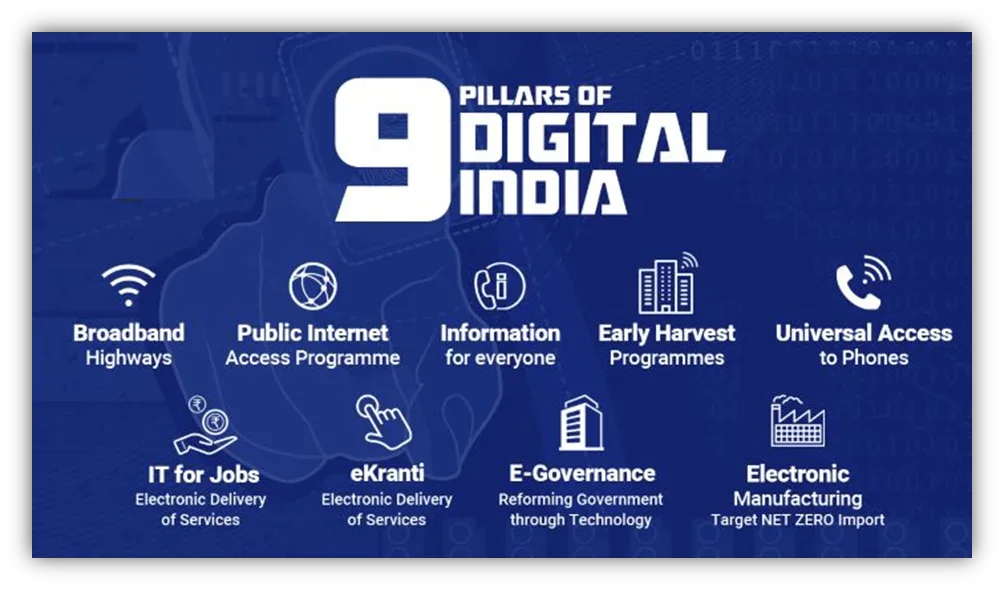-
08 Jul 2025
GS Paper 2
Polity & Governance
Day 20: “Digital India is not merely a technological mission; it is a governance transformation agenda.” Examine the extent to which Digital India has enhanced transparency, efficiency, and inclusiveness in public service delivery. (250 words)
Approach :
- Briefly introduce the Digital India Mission.
- Examine the extent to which Digital India has enhanced the given governance parameters.
- Highlight some challenges associated with the mission.
- Conclude with a suitable way forward.
Introduction:
The Digital India Mission, launched in 2015, aims to transform India into a digitally empowered society and knowledge economy. It is not just a technological initiative but a governance reform movement, striving to improve transparency, efficiency, and inclusiveness in public service delivery. Digital India exemplifies the shift from bureaucratic opacity to citizen-centric governance.
Body :
Transparency through Digital Platforms
- Direct Benefit Transfer (DBT) has eliminated intermediaries in schemes like PM-KISAN, PAHAL, and MNREGA, transferring ₹34+ lakh crore directly to beneficiaries (as of 2023).
- Platforms like PFMS, RTI Online, and MyGov facilitate real-time monitoring, public participation, and access to information.
- Digital payments and e-procurement portals like GeM ensure traceable transactions and reduce corruption.
Improved Efficiency in Governance
- UMANG integrates 1,700+ government services under a single app.
- DigiLocker, e-Sign, and Aadhaar-enabled services reduce paperwork and transaction time.
- e-Courts, e-Hospital, and e-Office streamline operations in critical public services.
- GeM portal has made procurement faster and more competitive, processing over ₹4 lakh crore worth of transactions.
Inclusiveness in Service Delivery
- Common Services Centres (CSCs) provide access to services in 2.5+ lakh gram panchayats.
- BharatNet extends broadband to rural and remote areas.
- PMGDISHA has imparted basic digital literacy to 6 crore citizens.
- Platforms like SWAYAM, DIKSHA, and e-Panchayat empower marginalized groups through access to education and e-governance.
Challenges in Implementation
- Digital Divide: NFHS-5 data reveals only 33% of rural women and 55% of men use the internet, reflecting gender and regional disparities.
- Infrastructure Gaps: Unstable electricity, poor connectivity in tribal and hilly regions hinder access.
- Cybersecurity & Data Privacy: The absence of a comprehensive data protection law raises risks of misuse and breaches.
- Digital Illiteracy: Many citizens, especially the elderly and poor, find digital platforms intimidating.
- Language Barriers: Most platforms are not available in local languages, excluding non-English speakers.
- Algorithmic Bias and Automation Exclusion: Tech-based platforms may reinforce social exclusion if not designed inclusively.
Way Forward
- Bridge the Digital Divide: Expand BharatNet and improve mobile internet in remote areas.
- Data Protection Framework: Expedite implementation of the Digital Personal Data Protection Act, 2023 to build trust.
- Digital Literacy Drives: Strengthen schemes like PMGDISHA and local training through CSCs.
- Localization: Promote multilingual platforms and content to enhance access.
- Public-Private Partnerships: Leverage innovation and resources from private tech firms to expand reach.
- Inclusive Design: Ensure digital platforms are user-friendly for the disabled, elderly, and linguistically diverse users.
Conclusion :
Digital India is not merely about introducing new technologies; it represents a paradigm shift in governance, aiming to make public services more accountable, participatory, and equitable. As Nandan Nilekani (founding Chairman of the Unique Identification Authority of India – UIDAI) rightly said, “If we can combine innovation with inclusion, and resilience with responsibility, India will not just lead in technology—it will be a custodian of the internet’s deepest values.”





